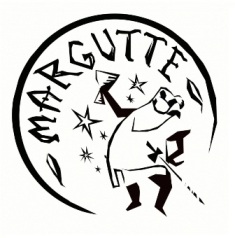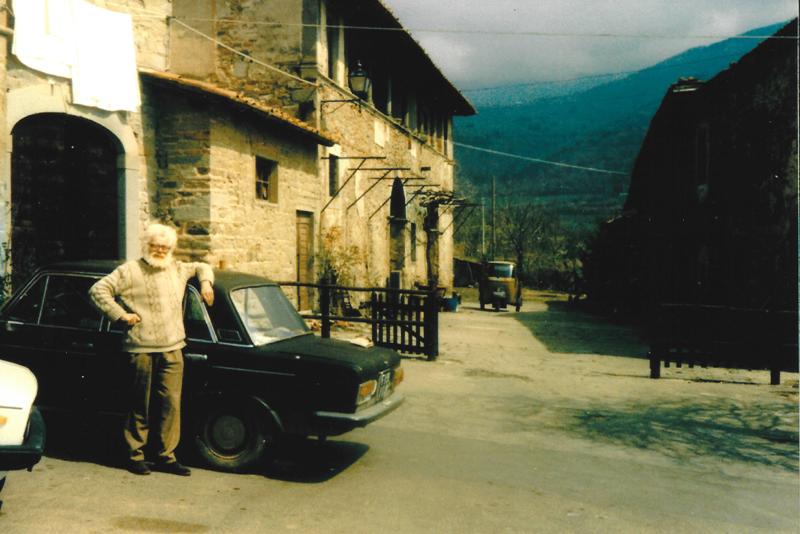SARA RUSSELL
The Golden Chain (self-published by the author, Venice, 1970; bilingual English-Italian edition: Florence: Paideia, 1998, reprinted in 2001) is a selection of poems written between 1963 and 1969. I helped my father prepare the first bilingual edition for publication in 1998 and am glad to have the opportunity to re-read some of the poems closely for this essay. I would like to thank my husband, Marco Prina, for his invaluable feedback and insights in the interpretation of the poems throughout.
From these poems, I have selected three which represent the relationship between poetry and creation very strikingly: “Blind Homer”, “The Golden Chain” and “Girl Painting” – maintaining the order in which they were published, while noting that my father did not fully order the poems in accordance with the chronological date in which they were written. For this essay, I have reworked the Italian translations (originally by Pier Franco Donovan and my brother, Peter George Russell) as I have deemed necessary for a more accurate understanding and interpretation of the poems.
Blind Homer
Blind Homer, sniggered at by the ignorant soldiery
Invented Olympus, propped among the mules;
And Greece exploded into golden flames, and Europe
Slowly grew out of his long hexameters.
Berlin,
9th August 1964
This poem celebrates not only Homer, of course, but the entire Western literary tradition. This is a re-writing of the incipit of the Gospel of John, but in this secular version it’s not the divine Logos, but rather the words, verses and musicality produced by the poet to illuminate the world and to bring forth civilization. Russell implicitly includes himself, as a syncretist and modernist poet, within the tradition begun by Homer and emphasizes his own role in re-recounting this tradition in poetic form.
The Golden Chain
I lay in fetters linked with bronze,
I begged a gift of the White Dove:
The silver chains that bind the swans,
The golden chain that binds my Love.
The Dove said: “Go to the Lake,
And take a withy in your hand.
Look on the sky and air, and make
A magic circle on the sand.
“Within the circle plant a seed;
Wait for the Tree to grow.
Look on the sun and moon, and heed
Word of neither friend nor foe.
“You’ll see the mountain-tops rise up;
You’ll see the earth turn into fish –
The deep lake seem a crystal cup
In which you’ll dream your chafing wish.
The fish will jump like silver birds
Out of the crystal bowl;
Sprout legs and dance, and utter words –
Words that will be your soul.
“Take all the words and write them down
On the leaves of the growing tree;
And let the starlight like a crown
Light up the leaves’ calligraphy.
“And read again, and read again
The words the green leaves spell!
And they will be the silver chain
And the golden chain as well.”
Venice,
11th April 1965
This poem melds poetry, prophecy, creation, transformation and metamorphosis. In this case, there is an explicit chain that reinforces the chain of poets implicit within the Western Tradition in the poem “Blind Homer”. Whereas in “Blind Homer” the focus is on the poet’s impact on the tradition, however, in the case of “The Golden Chain” the focus is on the poet’s own metaphysical journey, whose main symbol is the golden chain, a powerful neo-Platonic image.
The chains, as the reader will note, are three, as introduced in the first stanza. The first set of chains are the fetters of bronze which represent the poet’s limited vision within the shadow-world of the Platonic cave. The second set, the silver chains, represent the connection with the natural world. The third, and noblest, is the golden chain, which represents the poet’s aspiration for connection with divine Love – the common noun is capitalized to remind us that this Love is the Platonic form, not the earthly approximation.
The golden chain and the silver chain are connected, and the metamorphoses described in the dove’s prophecy are a reminder of the possibility for sublimation from the natural world to the divine realm, a realm to which poetry aspires to belong and which it aims to represent. I would like to point out two striking instances of metamorphosis.
The first instance is revealed by several key polysemic words. For example, both the words “leaves” and “spell” in the third-to-last line have more than one meaning. Beyond the literal meaning of “leaves” as foliage, the word denotes the pages of a book, and, less significantly, also signifies “departs”. Moreover, the double meaning of “spell” is introduced by the “magic” circle (line 8). In fact, “spell” denotes not just the string (or “chain”) of letters that form a word, but also a magic spell. In both of these instances of polysemy, at least one is directly related to writing in general and to the transformative power of poetry in particular. The metamorphoses elicited by the dove’s prophecy are paralleled by the metamorphosis of one meaning into another via a magical process, while still remaining contained within a single word.
The second instance is a third, and implicit, chain, of metamorphoses concentrated in a mere two lines. In the 5th stanza, the poet builds up a chain of metamorphoses, from mineral (crystal) to vegetable (“sprout”) to animal (“legs”) to human (“dance and utter words”) to spirit (“soul”) (lines 19-20).
Girl painting
You took some empty, watery, colourless space
And placed some pink and blue to make a flower
Light-green for stalk, and emerald at the base
For grass, black earth – but MAGIC made your shower;
Which rains transparencies of light and dew
And sunbeam full of pollen none can see;
It seemed that everything was there – but You,
So feminine, add dabs of brown – a bee.
I knew that touch was right – your white gauche hand
directed by some force we dared not name
Paused in its course to contemplate the land
Of light you’d made – and wonder whence it came;
I stood and looked, gushed – “Oh, it’s grand!”
And rushed out of the house to choose a frame.
Venice,
4th June 1965
I’ve chosen this poem in particular to complete the triad of creation poems because it represents creation from the point of view of both culture and nature, mediating between the two, which meld together to form something entirely new.
This poem re-writes the creation story from Genesis 1, casting as creator a powerful feminine force, conjuring up not just biblical imagery but ancient mythology and its Renaissance re-representation (Botticelli’s Birth of Venus, for example). The structure and content may appear simply framed at first glance. But just beyond the frame image of a girl painting while her companion looks on in admiration is an extraordinarily complex allegory that interweaves references to Boccaccio (implicitly through the frame-story itself and explicitly via the search for a “frame” for the painting), Sir Philip Sidney’s “Defence of Poesy” and the four layers of meaning from the “Letter to Cangrande” attributed to Dante. And perhaps the image of the female painter as powerful creative force also alludes to Artemisia Gentileschi’s “Self-Portrait as Allegory of Painting” –and the word “MAGIC”, emphasized by the choice of capitalized letters, evokes the supernatural, miraculous power behind the cosmos, narrative painting and poetry, building on the word “magic” in the poem “The golden chain”.
It should be noted that the word “gauche” (line 9) in the original leaves open both the idea of “uncertain” or awkward and the concept of left-handedness. This ambiguity may be read in juxtaposition with the un-nameable force that guides the painting hand in the verse that follows, and perhaps alluding to a contraposition between universal male and female energy. On another interconnected level, the un-nameable force implicitly refer to the Logos, which is by definition the power to name. Similarly, the concept of Logos is implicitly present by means of the allusion to the Gospel of John in the poem “Blind Homer”.
Sara Russell is the second-born daughter of the poet Peter Russell. She had the good fortune of living in different countries as a child, growing up surrounded by books and culture, which she has always appreciated as more precious than material goods. Sara earned her doctoral degree in Renaissance literature at the University of California, Berkeley, where she specialized in the Italian short story tradition from Boccaccio to Bandello. She lives in Italy with her husband, Marco, and their son, Gregorio.
The photo above belongs to the Russell family.



